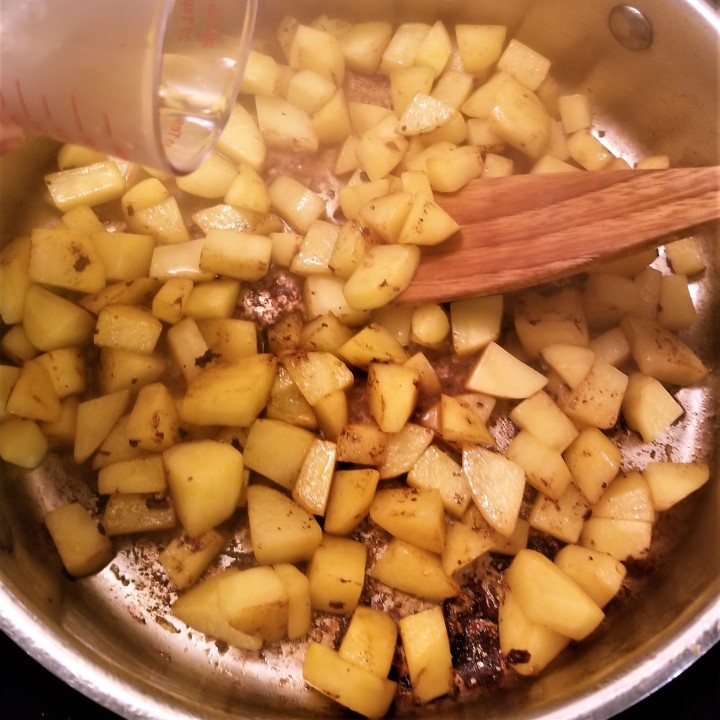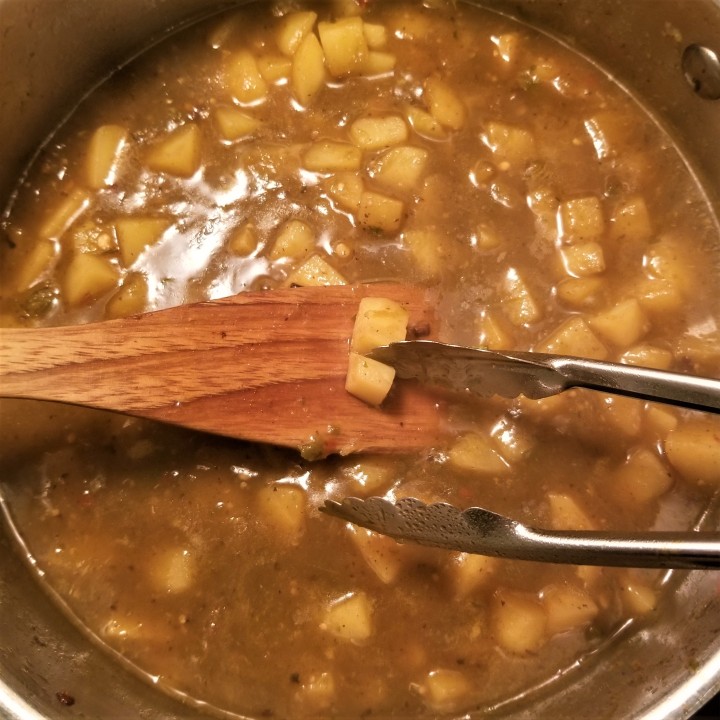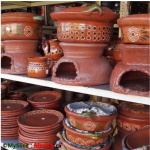
I have used chorizo for several recipes in this blog; it is a well-known type of pork sausage, originally from the Iberian Peninsula (Spain and Portugal). When pigs were introduced to the New World, Mexican versions seasoned with peppers (capsicum) soon appeared, presenting an infinite variety of shades of orange, red, and even green, depending on the peppers and other seasonings used in their preparation. The texture may vary according to meat to fat ratios, how fine or coarse the meat is ground, and how long the sausages are left to cure. In Mexico, chorizo meat is usually packed as a chain of links, which may be so short as to be almost spherical, or shaped as regular sausages (about 3-4 inches in length), or even longer. A similar product known as longaniza is, in some instances, identical to chorizo, except for the shape, prepared as a single long piece packed in tripe, instead of being tied into shorter links. However, at least as I remember it in Mexico, longaniza was usually fresh (meaning diametrically opposite to dry), or cured for only a short time, and prepared with meat with a coarser grind than chorizo. For this recipe, either Mexican chorizo or longaniza may be used, whichever variety is the freshest (less cured). I have never seen longaniza in my area, but I am able to find both cured and fresh Mexican style chorizos, for example, the ones shown in the photo below; the one on the left is a slightly cured chorizo packed in plastic sleeves, whereas the one on the right is fresh and packed in tripe:
I have made this dish with both, and they both taste very nice; however, the cured chorizo tends to be stronger and heavier so, as I have mentioned, I would recommend the fresh variety if available.
UPDATE October 2020: I have compared store-bought chorizo vs longaniza in Mexico and developed my own recipes for Coahuila style chorizo (with vegan option) and Yucatan style longaniza back at home in Canada; please click on highlighted texts for full stories and recipes.
Mexican Sausage in Green Sauce with Paddle Cacti
– Longaniza en salsa verde con nopales
Printable recipe: Mexican Sausage in Green Sauce with Paddle Cacti
Ingredients (approximately 4 portions)
1 lb (454 g) Mexican fresh chorizo or longaniza sausage
1 lb (454 g) potatoes; scrubbed, peeled, cubed
1 cup water, or more, as needed
2 cups cooked green sauce; homemade (check my recipe) or bottled
2 cups cooked paddle cacti (nopales); rinsed, drained and cut into strips (homemade or canned)
Slice sausages into sections approximately one-inch long; if the casing is natural, leave it on, and if it is plastic, remove it carefully after slicing, to preserve the shape of the pieces:

In a large pan over medium heat, cook the sausage pieces, turning frequently (photo below, left); once they are browned on all sides, transfer to a plate and reserve. Add the potatoes to the pan (photo below, right):
Stir the potatoes and fry in the fat from the sausages until slightly crispy, then add a quarter cup of water to deglaze the pan, scrapping any bits from the bottom (photo below, left); add green sauce and stir to coat the potatoes (photo below, right):
Add the rest of the water, and continue cooking for another 10 minutes, or until the potatoes are tender (photo below, left). Once the potatoes are tender, return the sausage to the pan, along with any liquid from the plate (photo below, right):
Stir, let simmer for five minutes, then add paddle cacti (nopales, photo below, left); stir gently to incorporate all the ingredients (photo below, right):
Add more water, if needed, and allow to simmer for at least another five minutes; adjust seasoning with salt and pepper, to taste (I did not use any, since the sausage, and my green sauce and nopales, were well seasoned already). Serve hot with corn tortillas:

My husband and I enjoyed generous portions for dinner, but this dish is very filling, and we had plenty of leftovers for another meal. Except for the cilantro and garlic in the green sauce, and the sausage, all the ingredients in this recipe were probably enjoyed in pre-Hispanic Mexico, including the potatoes, which had made their way up North to Mesoamerica from Peru since pre-Columbian times.
FUN FACT: My inspiration to share this dish came from Mexico’s coat of arms, which pictures the paddle cactus (nopal) and a snake being devoured by an eagle (see my previous post). In addition to the cacti, I thought the pieces of chorizo would be a fun reference to snake-shaped meat, which the Mexicas (Aztecs) apparently ate. However, as I learned while reading further, preparing snake meat (still eaten in Asia and Texas, amongst other places) requires skill, and there are many little bones which could make cooking and eating it quite cumbersome (and it does not taste like chicken, LOL). I guess I am very grateful for the fusion of European and Mesoamerican ingredients in this recipe.
I am joining Fiesta Friday # 265, graciously hosted by Angie @ Fiesta Friday, this week with Laurena @ Life Diet Health and Kat @ Kat’s 9 Lives.
I am also joining What’s for Dinner? Sunday Link-up #190 with Helen @ The Lazy Gastronome.
I am sharing my recipe with Miz Helen @ Miz Helen’s Country Cottage at her Full Plate Thursday Party #422
And last, but not least, I am bringing my recipe to Thursday Favourite Things with Katherine @ Katherine’s Corner, Nina @ Vintage Mama’s Cottage, Marilyn @ Marilyn’s Treats, Bev @ Eclectic Red Barn, Angelina @ Petite Haus, Amber @ Follow the Yellow Brick Home, Theresa @ Shoestring Elegance, and Linda @ Crafts a la Mode

















Is the cacti tinned or dried?
LikeLike
These were out of a can, so I rinsed and drained them. In a previous post:
https://mysliceofmexico.ca/2018/07/20/paddle-cactus-nopales/
I talked about the option of buying them fresh vs canned. I did not know you could get them dried.
LikeLiked by 1 person
Sorry Irene. I’ve such a bad memory. It looks delicious. My memory for images is much better. 🙂
LikeLiked by 1 person
My cousin married into a Mexican family last year, and we enjoyed a traditional soup at the rehearsal dinner. This dish looks very similar to what they served. Thanks for sharing the recipe at Fiesta Friday!
LikeLike
Oh yummy, what a lovely story, Kat!
LikeLiked by 1 person
I enjoy chorizo, but have never tried nopales. This looks like an excellent recipe for giving them a try!
LikeLike
Absolutely, Eilene!
LikeLiked by 1 person
This looks really good. I am a huge fan of nopales also. Do you add any chile?
LikeLike
My green sauce was medium-hot already, but if mild, yes you may add some chopped serranos or jalapeños, to taste
LikeLiked by 1 person
Nopales are a taste that (sometimes) comes with time, an aquired taste. I love them. They are very good for a person’s health, especially for those that deal with diabetes, eyesite, and weight. I like them cooked or uncooked. My wife has to have them cooked. They are much like aloe vera when uncooked. I love them in omelets (which sometimes includes chorizo), soups, and may other ways.
Happy eating.
LikeLiked by 1 person
Absolutely, and in smoothies and grilled are another two ways to enjoy them; thank you for your comment, Jason!
LikeLiked by 1 person
Thanks for the additional info about them!
LikeLiked by 2 people
Oh Irene! I’m dying to taste this one! Thanks so much for sharing! I have a jar of nopales in the pantry that I’d been wanting to use.
LikeLike
I hope you like it, Jennifer!
LikeLiked by 1 person
Ooo a new ingredient for me to find! I’ve never even heard of nopales – how exciting! I’ve had freshly picked cactus fruit when I was in Morocco, but I didn’t know you could eat the leaves! I hope I can find some so I can make this (with a vegan chorizo)! 😀 Thanks for linking up and sharing at Fiesta Friday.
LikeLiked by 1 person
Hi, Laurena, thank you for hosting this week!
I have a post describing the nopales, both canned and fresh:
https://mysliceofmexico.ca/2018/07/20/paddle-cactus-nopales/
My daughter is vegetarian and likes: The Original Field Roast Company’s Mexican Chipotle vegan sausage, very close to Mexican chorizo.
LikeLiked by 2 people
Ooo thanks Irene! I think we can get Original Field Roast here so I’ll have a look! Thanks for the link – I’ll check it out!.
LikeLiked by 1 person
It looks tasty!!!
I love Chorizo 🙂
LikeLike
I didn’t know snake meat had lots of bones. Your recipe looks yummy. I keep buying cactus paddles at the dollar store whenever they have packets for $1 but so far haven’t made anything with them yet. Cooking delusions of grandeur on my part, lol. I’m always impressed by the wide variety of Mexican food you make — since the restaurants here typically serve the same fare, I had no idea it was so varied until your website.
LikeLike
Yeah, me neither, but since snakes are vertebrates, their spine is comprised of many short bones so they may slither around, hehe. There are so many different Mexican dishes, and different versions depending on region or season! Are those $1 cacti fresh? You could even try them raw, processed in the blender with orange juice; people drink that as a natural health aid (I do not know the science, but I have heard that it helps regulate blood pressure, and diabetes, amongst a bunch of other health benefits)
LikeLiked by 1 person
Really? I don’t know how fresh they are though. That’s cool about the health benefits. If it regulates diabetes, bet it helps with weight too because I’ve noticed other plants that help with diabetes also often have a thing that says they help with weight too. Cinnamon is like that. At a farmer’s market I went to, someone made potato chips but from cactus paddles instead — sliced thin, of course. I can’t remember now if they were fried or baked. It tasted pretty good especially with the salsa. have you ever tried to make baked chips with cactus? Just curious.
LikeLiked by 1 person
Nope, but I would guess they were fried because with all that water content they would get wrinkly in the oven, wouldn’t they? I might try one of these days …
LikeLiked by 1 person
I encourage anyone interested in nopales to go read this article on the benefits of nopales. Here is the link if you would like to know more. https://www.organicfacts.net/health-benefits/vegetable/nopales.html
My wife and I are going to be using it for weight loss.
LikeLike
I can almost smell this delicious combination and thanks so much for sharing them with us at Full Plate Thursday. Hope you are having a great week and come back soon!
Miz Helen
LikeLike
Thank you so much, Miz Helen!
LikeLike
This looks great! I may have to make my own fresh or lightly cured chorizo, as I think we only get the dried/Spanish version here.
LikeLike
Mmm, yes fresh chorizo would be the best in this particular case, thank you for your comment, Stefan!
LikeLiked by 1 person
Congratulations! Your post was my feature pick at #ThursdayFavoriteThings this week. Visit me at https://www.marilynstreats.com on thursday morning to see your feature! All hosts choose their own features from the comments left on their blog so be sure to return to my blog to see your feature. I invite you to leave more links to be shared and commented upon. Please don’t forget to add your link numbers or post title so we can be sure to visit!
LikeLike
Wow, thank you for the feature and for letting me know, Marilyn! I will for sure visit your blog tomorrow. Thank you for hosting!
LikeLike
I am confused, so what is the difference between chorizo and longaniza? In Mexico, city, you go to any market and what people there call “longaniza” is a very long sausage with a hard texture , hard to crumble, intense flavor similar to al pastor meat.
Longaniza is what my mom or aunts always bought to make that dish longaniza con nopales.
In the US, the sausage that it advertised as Mexican chorizo is horrible, the texture is kind of wet, not intense flavor, it crumbles super easily.I have never seen such horrible sausage(US-Mexican chorizo) in Mexico city, and the longaniza I know it is impossible to find in the US.
LikeLiked by 1 person
Spain, Portugal, the Philippines and each Latin American country has a diferent definition of chorizo and longaniza. For some people in Mexico, chorizo and longaniza are interchangeable, calling longaniza the long “ropes” of sausage, and chorizo, the shorter links. I grew up in Mexico City, and longaniza were the ones you describe, yes, traditionally used in this dish, and chorizo had a stronger flavour, usually cured for longer time that longaniza and cooked crumbled or as a sausage, sometimes on the grill; it might not be as good as longaniza for this dish, but it is the best in tortas (Mexican sandwiches) and tacos. You are right that what you find packed in the US (and my experience in Canada) is not close to Mexican chorizo (or longaniza) and the fresh sausage I showed here probably has more of a Portuguese influence (Portuguese nationals might not agree, of course). All that said, though, it was the best approximation I found around here for this recipe, which did not fall apart during cooking, and what I remember eating at fondas (small eateries) and cocinas economicas (take-out home-style restaurants). Next time you go to Mexico, look for a good chorizo (in short links, and Mexican, not Spanish), it is very hard to describe the difference. I am going to Mexico next month so I will make it a point to take some pics at a market and a supermarket, and report back. Thank you for the inspiration, Chimichango!
LikeLike